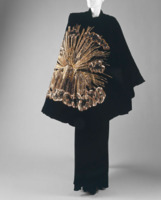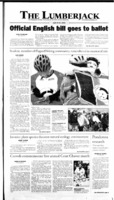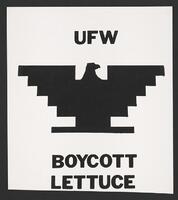-
 "Apollo of Versailles"
"Apollo of Versailles" Elsa Schiaparelli designed this cape in 1938 as part of her winter Cosmique collection, which featured designs inspired by the heavenly bodies and the field of astronomy. The cape depicts the Greek god of the sun, Apollo, in the foreground with brilliant rays of gold bursting in the background like solar rays. Apollo’s chariot and bow are also depicted using gold and metallic thread, beads, and paillettes. Schiaparelli chose this particular deity to reflect her client Lady Mendl, an American actress and interior designer who resided at the Villa Trianon in Versailles at the time. Mendl’s villa lies across from the fountain of Apollo at the Palace of Versailles. The cape not only captures the elegance and intricacy of Schiaparelli’s designs, but also the opulence of Lady Mendl who was widely regarded for her style.
-
 César Chávez’s Union Jacket
César Chávez’s Union Jacket This jacket was worn by Cesar Chavez who founded the United Farm Workers movement in 1962. Chavez and his associates dedicated their lives to improving the working and living conditions of Hispanic migrant farm workers in the United States. The United Farm Workers utilized boycotts and strikes, popular methods of political resistance in the 1960s, to communicate their demands to individual farmers and the American public. Cesar Chavez also drew on other tactics used by his political inspirations, such as Mahatma Gandhi, and partook in hunger strikes to encourage farmers to listen to the pleas of the farmworkers. Chavez remained politically active up to his death in 1993. Former President Bill Clinton posthumously awarded Cesar Chavez the Presidential Medal of Freedom in 1994.
-
 The Lumberjack, April 14, 2005.
The Lumberjack, April 14, 2005. This edition of Northern Arizona University’s student-run newspaper, The Lumberjack, features an article about the first annual Cesar Chavez march in April of 2005. The march was organized by a Hispanic student organization, Movimiento Estudiantil Chicana/o de Aztlán (M.E.Ch.A), at NAU to honor the memory of the United Farm Workers’ leader. M.E.Ch.A hoped to raise awareness about the important role that Cesar Chavez played in the fight for Hispanic migrant workers’ rights as well as his influence on the overall Chicano population of the United States. The march started at the first Chicano church in Flagstaff, Our Lady of Guadalupe Chapel, and continued on through the city of Flagstaff, Arizona.
-
 The Lumberjack, April 5, 2007.
The Lumberjack, April 5, 2007. This 2007 edition of Northern Arizona University’s student-run newspaper, The Lumberjack, covered the third annual Cesar Chavez march in Flagstaff, Arizona. The article provides insight into some of the important reforms that the United Farm Workers association secured for migrant farm workers in the American Southwest, including better wages and working conditions. Participants praised the UFW’s leaders Cesar Chavez and Dolores Huerta for their political activism which was responsible for such reforms. They carried posters bearing the UFW’s symbol, pictures of Cesar Chavez, and other symbols from the Civil Rights movement such as the raised fist. NAU’s Hispanic student organization, Movimiento Estudiantil Chicana/o de Aztlán (M.E.Ch.A), founded the annual march in April of 2005. Subsequent marches, like this one from 2007, brought Flagstaff’s Hispanic population together to celebrate their heritage and cultural icons.
-
 UFW Boycott lettuce.
UFW Boycott lettuce. This image features the symbol of the United Farm Workers labor union founded in 1962. The eagle was designed by Richard Chavez, brother of the UFW’s founder Cesar Chavez, and drew on the iconographic style of the Aztecs. Using the Aztec eagle was a way to connect the UFW to the Mexican heritage of its members and further legitimize the movement. Richard Chavez also designed the symbol in a simple style that would be easy to reproduce on posters, signs, and other materials used during protests and boycotts. The eagle was also featured on legal documents, such as contract negotiations, and became an important emblem of the UFW’s successes.
 "Apollo of Versailles" Elsa Schiaparelli designed this cape in 1938 as part of her winter Cosmique collection, which featured designs inspired by the heavenly bodies and the field of astronomy. The cape depicts the Greek god of the sun, Apollo, in the foreground with brilliant rays of gold bursting in the background like solar rays. Apollo’s chariot and bow are also depicted using gold and metallic thread, beads, and paillettes. Schiaparelli chose this particular deity to reflect her client Lady Mendl, an American actress and interior designer who resided at the Villa Trianon in Versailles at the time. Mendl’s villa lies across from the fountain of Apollo at the Palace of Versailles. The cape not only captures the elegance and intricacy of Schiaparelli’s designs, but also the opulence of Lady Mendl who was widely regarded for her style.
"Apollo of Versailles" Elsa Schiaparelli designed this cape in 1938 as part of her winter Cosmique collection, which featured designs inspired by the heavenly bodies and the field of astronomy. The cape depicts the Greek god of the sun, Apollo, in the foreground with brilliant rays of gold bursting in the background like solar rays. Apollo’s chariot and bow are also depicted using gold and metallic thread, beads, and paillettes. Schiaparelli chose this particular deity to reflect her client Lady Mendl, an American actress and interior designer who resided at the Villa Trianon in Versailles at the time. Mendl’s villa lies across from the fountain of Apollo at the Palace of Versailles. The cape not only captures the elegance and intricacy of Schiaparelli’s designs, but also the opulence of Lady Mendl who was widely regarded for her style. César Chávez’s Union Jacket This jacket was worn by Cesar Chavez who founded the United Farm Workers movement in 1962. Chavez and his associates dedicated their lives to improving the working and living conditions of Hispanic migrant farm workers in the United States. The United Farm Workers utilized boycotts and strikes, popular methods of political resistance in the 1960s, to communicate their demands to individual farmers and the American public. Cesar Chavez also drew on other tactics used by his political inspirations, such as Mahatma Gandhi, and partook in hunger strikes to encourage farmers to listen to the pleas of the farmworkers. Chavez remained politically active up to his death in 1993. Former President Bill Clinton posthumously awarded Cesar Chavez the Presidential Medal of Freedom in 1994.
César Chávez’s Union Jacket This jacket was worn by Cesar Chavez who founded the United Farm Workers movement in 1962. Chavez and his associates dedicated their lives to improving the working and living conditions of Hispanic migrant farm workers in the United States. The United Farm Workers utilized boycotts and strikes, popular methods of political resistance in the 1960s, to communicate their demands to individual farmers and the American public. Cesar Chavez also drew on other tactics used by his political inspirations, such as Mahatma Gandhi, and partook in hunger strikes to encourage farmers to listen to the pleas of the farmworkers. Chavez remained politically active up to his death in 1993. Former President Bill Clinton posthumously awarded Cesar Chavez the Presidential Medal of Freedom in 1994. The Lumberjack, April 14, 2005. This edition of Northern Arizona University’s student-run newspaper, The Lumberjack, features an article about the first annual Cesar Chavez march in April of 2005. The march was organized by a Hispanic student organization, Movimiento Estudiantil Chicana/o de Aztlán (M.E.Ch.A), at NAU to honor the memory of the United Farm Workers’ leader. M.E.Ch.A hoped to raise awareness about the important role that Cesar Chavez played in the fight for Hispanic migrant workers’ rights as well as his influence on the overall Chicano population of the United States. The march started at the first Chicano church in Flagstaff, Our Lady of Guadalupe Chapel, and continued on through the city of Flagstaff, Arizona.
The Lumberjack, April 14, 2005. This edition of Northern Arizona University’s student-run newspaper, The Lumberjack, features an article about the first annual Cesar Chavez march in April of 2005. The march was organized by a Hispanic student organization, Movimiento Estudiantil Chicana/o de Aztlán (M.E.Ch.A), at NAU to honor the memory of the United Farm Workers’ leader. M.E.Ch.A hoped to raise awareness about the important role that Cesar Chavez played in the fight for Hispanic migrant workers’ rights as well as his influence on the overall Chicano population of the United States. The march started at the first Chicano church in Flagstaff, Our Lady of Guadalupe Chapel, and continued on through the city of Flagstaff, Arizona. The Lumberjack, April 5, 2007. This 2007 edition of Northern Arizona University’s student-run newspaper, The Lumberjack, covered the third annual Cesar Chavez march in Flagstaff, Arizona. The article provides insight into some of the important reforms that the United Farm Workers association secured for migrant farm workers in the American Southwest, including better wages and working conditions. Participants praised the UFW’s leaders Cesar Chavez and Dolores Huerta for their political activism which was responsible for such reforms. They carried posters bearing the UFW’s symbol, pictures of Cesar Chavez, and other symbols from the Civil Rights movement such as the raised fist. NAU’s Hispanic student organization, Movimiento Estudiantil Chicana/o de Aztlán (M.E.Ch.A), founded the annual march in April of 2005. Subsequent marches, like this one from 2007, brought Flagstaff’s Hispanic population together to celebrate their heritage and cultural icons.
The Lumberjack, April 5, 2007. This 2007 edition of Northern Arizona University’s student-run newspaper, The Lumberjack, covered the third annual Cesar Chavez march in Flagstaff, Arizona. The article provides insight into some of the important reforms that the United Farm Workers association secured for migrant farm workers in the American Southwest, including better wages and working conditions. Participants praised the UFW’s leaders Cesar Chavez and Dolores Huerta for their political activism which was responsible for such reforms. They carried posters bearing the UFW’s symbol, pictures of Cesar Chavez, and other symbols from the Civil Rights movement such as the raised fist. NAU’s Hispanic student organization, Movimiento Estudiantil Chicana/o de Aztlán (M.E.Ch.A), founded the annual march in April of 2005. Subsequent marches, like this one from 2007, brought Flagstaff’s Hispanic population together to celebrate their heritage and cultural icons. UFW Boycott lettuce. This image features the symbol of the United Farm Workers labor union founded in 1962. The eagle was designed by Richard Chavez, brother of the UFW’s founder Cesar Chavez, and drew on the iconographic style of the Aztecs. Using the Aztec eagle was a way to connect the UFW to the Mexican heritage of its members and further legitimize the movement. Richard Chavez also designed the symbol in a simple style that would be easy to reproduce on posters, signs, and other materials used during protests and boycotts. The eagle was also featured on legal documents, such as contract negotiations, and became an important emblem of the UFW’s successes.
UFW Boycott lettuce. This image features the symbol of the United Farm Workers labor union founded in 1962. The eagle was designed by Richard Chavez, brother of the UFW’s founder Cesar Chavez, and drew on the iconographic style of the Aztecs. Using the Aztec eagle was a way to connect the UFW to the Mexican heritage of its members and further legitimize the movement. Richard Chavez also designed the symbol in a simple style that would be easy to reproduce on posters, signs, and other materials used during protests and boycotts. The eagle was also featured on legal documents, such as contract negotiations, and became an important emblem of the UFW’s successes.